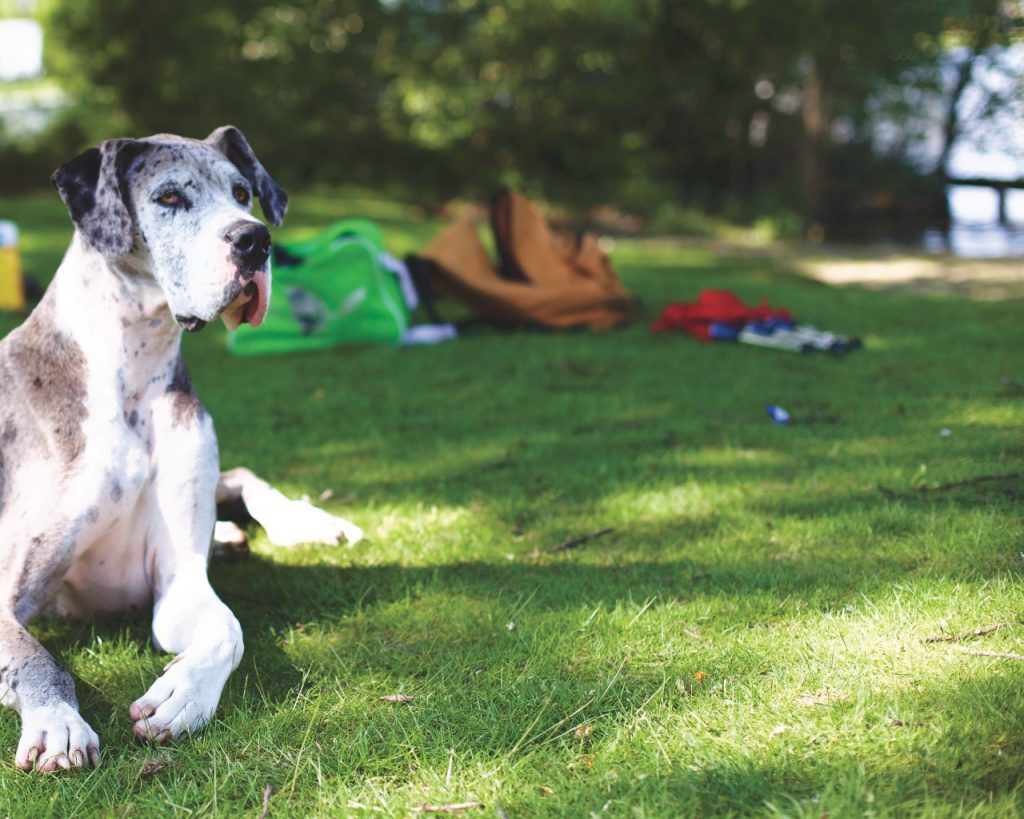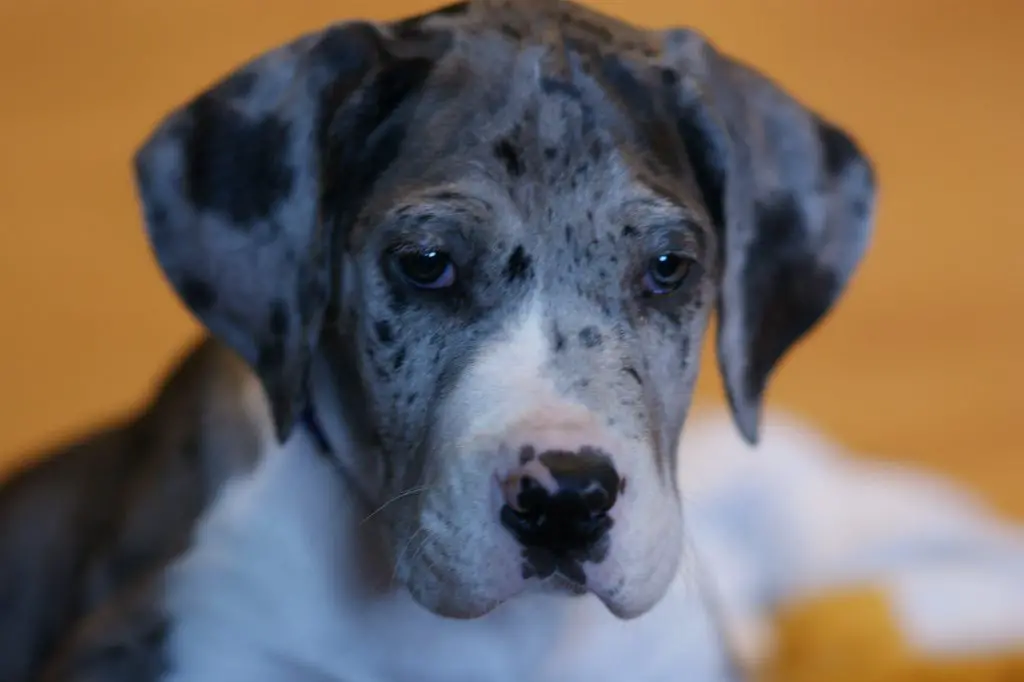If you are looking for a unique dog breed, the Merle Great Dane is definitely worth considering. This dog has beautiful coloring and an interesting personality. But, what is a Merle Great Dane?
Have you ever seen a Great Dane that was a different color than the typical black and tan? If so, you may have seen a Merle Great Dane.
Read on to find more about this beautiful and unique dog.
Key Takeaway
- A Merle Great Dane is a type of Great Dane breed that is characterized by its unique coat pattern, typically lighter with darker gray spots or splotches, due to a genetic material inserted into a pigment gene called SILV.
- Merle Great Danes are not necessarily uncommon, but they are less prevalent than some other colors like grey, black, and white, leading some breeders to advertise them as “rare” and sell them at a premium price.
What Is A Merle Great Dane?

A Merle Great Dane is a variant of the Great Dane breed, distinguished by its unique coat pattern which is typically lighter with darker gray spots or splotches, due to a specific genetic trait.
Merle Great Danes are recognized for their distinctive coats, which exhibit a mottled pattern of color patches against a lighter base.
This pattern is typically a mix of gray, blue, black, or white spots or splotches on a lighter coat color, due to a specific genetic trait.
The merle gene that causes this coloration is dominant, meaning that even if only one parent has the gene, there’s a chance the puppies will inherit it.
Despite their striking appearance, it’s important to note that breeding two merle dogs can result in health issues for the puppies, including deafness and blindness.
Therefore, responsible breeders avoid mating two merle dogs together.
What Makes a Merle Great Dane

A Merle Great Dane is a variation of the Great Dane breed, distinguished by its unique mottled coat pattern, typically featuring darker gray spots or splotches on a lighter base, caused by a specific genetic trait known as the SILV gene.
Merle Great Danes are captivating animals recognized by their distinct coat pattern. This coat is usually lighter in color, covered with darker grey spots or patches.
The unique appearance of the Merle Great Dane is due to an additional piece of genetic material inserted into a pigment gene called SILV, which all dogs carry.
This results in the mottled pattern of colors, typically blue, with dark and light cloudy patches that give the Merle Great Dane its striking look.
While these dogs may be marketed as rare colored Danes in some classified ads or for sale, they are commonly produced in many Harlequin Great Dane litters.
Are Merle Great Danes Uncommon?
Merle Great Danes are not uncommon, but they are less prevalent than some other colors such as fawn, black, or brindle, leading some breeders to label them as “rare”.
The Merle Great Dane is a variant of the Great Dane breed that is distinguished by its particular coat pattern.
The coat has a mottled appearance with darker spots or patches against a lighter base. This striking pattern is caused by a specific genetic trait.
While Merle Great Danes are not as common as other color variants in the breed, they are not considered rare.
The perception of rarity can be attributed to their unique coloring, which is less frequently seen compared to other color types like fawn, black, or brindle.
Despite this, it’s important to note that the merle gene can lead to certain health issues if two merle dogs are bred together, so responsible breeding practices are essential.
Merle Great Dane Varieties
Merle Great Danes come in a variety of color patterns, each distinguished by unique combinations of colors and markings due to the influence of the merle gene.
Blue Merle Great Dane
Blue Merle Great Danes have a base coat that is a lighter blue-gray color with darker splotches or patches. This color is caused by the dilution of the black pigment due to the merle gene.
Harlequin Merle Great Dane
Harlequin Merle Great Danes are characterized by a white base coat with irregular black patches. Sometimes, the merle gene can influence the color of these patches, turning them into a gray-blue hue.
Chocolate Merle Great Dane
Chocolate Merle Great Danes possess a light brown or beige coat with darker brown patches. The Merle gene contributes to the mottled appearance of the coat.
Fawn Merle Great Dane
Fawn Merle Great Danes have a light fawn-colored base coat with darker brown or black patches. The Merle gene causes the distinctive splotched pattern on the coat.
Each of these varieties is influenced by the merle gene, which creates the characteristic mottled or dappled appearance of the coat. Despite their striking appearance, it’s crucial to remember that potential health risks can arise from this genetic trait, making responsible breeding practices important says Hepper.
Health Concerns for Merle Great Danes
Merle Great Danes can potentially face more health issues than other color variations of the breed due to the merle gene, including hearing and vision problems and a condition known as “double merle.”
Hearing and Vision Problems
Merle Great Danes may have an increased risk of hearing and vision problems. The merle gene can cause irregularities in the development of the inner ear, leading to deafness. Similarly, it can lead to eye defects, including small eyes or irregularly shaped pupils, which can affect the dog’s vision.
Double Merle Condition
The “double merle” condition occurs when two merle dogs are bred together, resulting in offspring that inherit two copies of the merle gene. These Double Merles often have a predominantly white coat and are more likely to suffer from severe vision or hearing impairments. This condition is a direct result of irresponsible breeding practices.
General Health Concerns
Like all Great Danes, Merle Great Danes are also prone to certain breed-specific health issues. These include heart conditions like dilated cardiomyopathy, hip dysplasia, and gastric torsion, also known as bloat.
Breeding Problems with Merle Great Danes
Breeding Merle Great Danes can lead to significant health problems, particularly if two merle dogs are bred together, due to the genetic implications of the merle gene.
Double Merle Condition
When two merle dogs are bred together, there’s a high chance of producing “double merle” offspring. These dogs inherit two copies of the merle gene and are highly likely to suffer from severe hearing and vision impairments, and in some cases, complete blindness and deafness.
Increased Risk of Deafness
Research indicates that dogs with the merle gene have a 2.7% chance of developing deafness. This risk increases to 10% for double merles. The merle gene can cause irregularities in the development of the inner ear, leading to deafness.
Potential for Blindness
Just as with hearing, the merle gene can lead to eye defects, including small eyes or irregularly shaped pupils, which can affect the dog’s vision. In some cases, this can result in complete blindness, especially in double merles.
Risk of Stillborn or Sick Puppies
Breeding merles can result in stillborn or sick puppies. There’s also an increased risk of the puppies being predisposed to future health problems. This is because the merle gene can interfere with normal development, leading to various health issues.
General Health Concerns
In addition to these specific issues related to the merle gene, Merle Great Danes, like all Great Danes, are also prone to certain breed-specific health issues. These include heart conditions like dilated cardiomyopathy, hip dysplasia, and gastric torsion, also known as bloat.
FAQs
Q: How is the coat of a Merle Great Dane different from other Great Danes?
A: The coat of a Merle Great Dane is different from other Great Danes in terms of color pattern. While regular Great Danes may have a solid base color or a combination of two colors, Merle Great Danes have a mottled or marbled pattern with patches or spots of different shades or colors mixed in the base color.
Q: Are there specific color variations in Merle Great Danes?
A: Yes, Merle Great Danes can come in a variety of color variations such as blue merle, black merle, chocolate merle, and harlequin merle. Each variation has its own unique combination of colors and patterns.
Q: Are Merle Great Danes a recognized breed standard?
A: No, Merle Great Danes are not recognized as a separate breed standard. The Great Dane breed standard typically recognizes solid-colored coats or specific color combinations, but not the merle pattern. However, Merle Great Danes can still be registered and participate in various dog events and shows.
Q: How is the merle pattern inherited in Great Danes?
A: The merle pattern in Great Danes is inherited through a dominant gene called the Merle gene. When a Great Dane inherits two copies of the Merle gene, it can result in a higher risk of certain health issues, such as hearing or vision problems. Careful breeding practices are necessary to ensure the health and well-being of Merle Great Danes.
Q: Can Merle Great Danes have blue eyes?
A: Yes, Merle Great Danes can have blue eyes. The merle gene can sometimes cause variation in eye color, and it is not uncommon for Merle Great Danes to have one or both blue eyes. However, not all Merle Great Danes have blue eyes, and eye color can also depend on other genetic factors.
Q: Are Merle Great Danes more prone to certain health issues?
A: Yes, Merle Great Danes can be more prone to certain health issues, especially if they inherit two copies of the Merle gene. Some common health issues associated with Merle Great Danes include deafness, vision problems, and increased susceptibility to sunburn and skin issues. It is important for owners to be aware of these potential health risks and provide appropriate care.
Q: Can I breed a Merle Great Dane with another Merle Great Dane?
A: Breeding a Merle Great Dane with another Merle Great Dane is generally not recommended. When two Merle Great Danes are bred together, there is a higher chance of producing puppies with two copies of the Merle gene, which can increase the risk of health issues. Responsible breeding practices aim to avoid such risks by carefully selecting mates to produce healthy offspring.
Q: Can Merle Great Danes be shown in dog shows?
A: Yes, Merle Great Danes can be shown in dog shows, even though they may not conform to the breed standard. However, it is important to note that judges may give preference to Great Danes with recognized and accepted color patterns over Merle Great Danes. The focus of dog shows is primarily on the conformation, health, and temperament of the dog, rather than the specific coat color.
Q: Do Merle Great Danes have any specific personality traits?
A: While coat color does not directly determine personality traits, Great Danes as a breed are known for their gentle, friendly, and patient nature. This applies to Merle Great Danes as well. They are generally loyal and affectionate companions, but individual personalities can vary.
Conclusion and final thoughts
In conclusion, we have discussed the unique characteristics of a Merle Great Dane and how it differs from other Great Dane colors.
From their striking coat patterns to their potential health risks, these dogs are truly one-of-a-kind.
While they may not be recognized by all kennel clubs, they continue to capture the hearts of dog lovers around the world.




